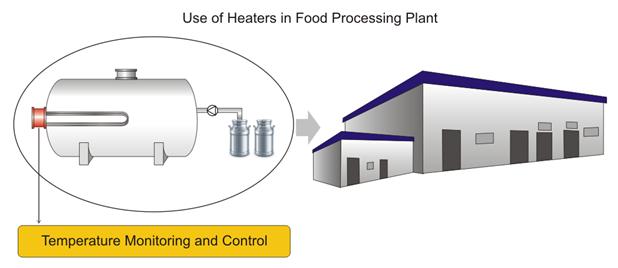Use of Screw Plug and Flange Heaters in the Food Industry
 Heat is of utmost importance in the food industry. Certain liquid foods need to be heated and stored at a particular temperature to prevent spoiling. Cooking oils need to be heated to a precise temperature. Hot water is required to make food containers sterile to prevent food contamination. Heating meat products to specific temperatures can extend their shelf life. The heating of meat products is also required to destroy the microorganisms that are present in the meat.
Heat is of utmost importance in the food industry. Certain liquid foods need to be heated and stored at a particular temperature to prevent spoiling. Cooking oils need to be heated to a precise temperature. Hot water is required to make food containers sterile to prevent food contamination. Heating meat products to specific temperatures can extend their shelf life. The heating of meat products is also required to destroy the microorganisms that are present in the meat.
Why screw plug and flanged heaters have gained popularity
In the past, fuel-based heaters were used in the food industry. However, nowadays, electric heaters are used (see Figure 1) because they are more economical. Unlike fuel heaters, electric heaters also have the benefit of not polluting the atmosphere.
Of the different types of electric heaters, screw plug and flange heaters are most popular in the food industry. Both, screw plug and flange heaters run on electricity and provide for even heating of liquids. Since the heating elements are immersed in the liquids, in the case of screw plug and flange heaters, the containers where such heaters are fixed can be completely sealed. This provides a more even and uniform heating of the contents. Furthermore, because these heaters can be used to heat liquids inside sealed containers, those involved in food preparation will not be exposed to the heated liquids. Thus, screw plug and flange heaters are safety options for heating liquids as compared to the other non-submersible types of heaters.
Application of screw plug and flanged heaters in food processing
Milk and juices need to be pasteurized—heated to specific temperatures—to destroy or get rid of the germs in them. Cans for preserving and transporting food need to be washed in hot water—sometimes at temperatures as high as 110-121 deg. Celsius (230-250 deg. Fahrenheit)—to make them sterile to prolong food life. Some foodstuffs lose their vitamin or nutritional content if heated to too high a temperature. Thus, it is very important to keep a tight control over the temperature of the heating equipment.
Screw plug heaters can be fitted with digital or mechanically operated thermostats to monitor and control the temperature of the liquids. Flange heaters come with a pre-installed thermostat that controls the temperature of the heater. The thermostat contains a heat sensor that transmits the readings to a digital temperature controller, thus allowing accurate monitoring of the temperature within the container.
Versatility of screw plug and flanged heaters in food processing
Screw plug and flange heaters can heat liquids of any density. Thus, these heaters can be used to heat various kinds of liquids used in the food industry, such as water, milk, juices, and cooking oil.
Since immersion heaters directly heat the liquid, the liquid food items heat up to the desired temperature much faster than if they were to be heated using indirect heating methods such as with pipe heaters. Immersion heaters have thermocouples that can cut off the heat if it exceeds a pre-determined value.
Another advantage of screw plug heaters is that the heating element is attached or welded to a screw plug. Thus, these heaters can easily be screwed into the side of a tank or container. Furthermore, since it is easy to install a screw plug heater in any container, screw plug heaters can easily be moved from one container to another depending on heating requirements.
Screw plug and flange heaters provide many benefits to the food industry in terms of safety, temperature control, and economy. Thus, they are preferred over other types of heaters.

Figure 1
